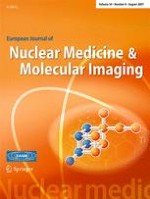Published in:

01-08-2007 | Original article
Assessment of coronary flow reserve by sestamibi imaging in patients with typical chest pain and normal coronary arteries
Authors:
Giovanni Storto, Anna Rita Sorrentino, Teresa Pellegrino, Raffaele Liuzzi, Mario Petretta, Alberto Cuocolo
Published in:
European Journal of Nuclear Medicine and Molecular Imaging
|
Issue 8/2007
Login to get access
Abstract
Purpose
We assessed coronary flow reserve (CFR) by sestamibi imaging in patients with typical chest pain, positive exercise stress test and normal coronary vessels.
Methods
Thirty-five patients with typical chest pain and normal angiogram and 12 control subjects with atypical chest pain underwent dipyridamole/rest 99mTc-sestamibi imaging. Myocardial blood flow (MBF) was estimated by measuring first transit counts in the pulmonary artery and myocardial counts from SPECT images. Estimated CFR was expressed as the ratio of stress to rest MBF. Rest MBF and CFR were corrected for rate–pressure product (RPP) and expressed as normalised MBF (MBFn) and normalised CFR (CFRn). Coronary vascular resistances (CVR) were calculated as the ratio between mean arterial pressure and estimated MBF.
Results
At rest, estimated MBF and MBFn were lower in controls than in patients (0.98 ± 0.4 vs 1.30 ± 0.3 counts/pixel/s and 1.14 ± 0.5 vs 1.64 ± 0.6 counts/pixel/s, respectively, both p < 0.02). Stress MBF was not different between controls and patients (2.34 ± 0.8 vs 2.01 ± 0.7 counts/pixel/s, p=NS). Estimated CFR was 2.40 ± 0.3 in controls and 1.54 ± 0.3 in patients (p < 0.0001). After correction for the RPP, CFRn was still higher in controls than in patients (2.1 ± 0.5 vs 1.29 ± 0.5, p < 0.0001). At baseline, CVR values were lower (p < 0.01) in patients than in controls. Dipyridamole-induced changes in CVR were greater (p < 0.0001) in controls (−63%) than in patients (−35%). In the overall study population, a significant correlation between dipyridamole-induced changes in CVR and CFR was observed (r = −0.88, p < 0.0001).
Conclusion
SPECT might represent a useful non-invasive method for assessing coronary vascular function in patients with angina and a normal coronary angiogram.





